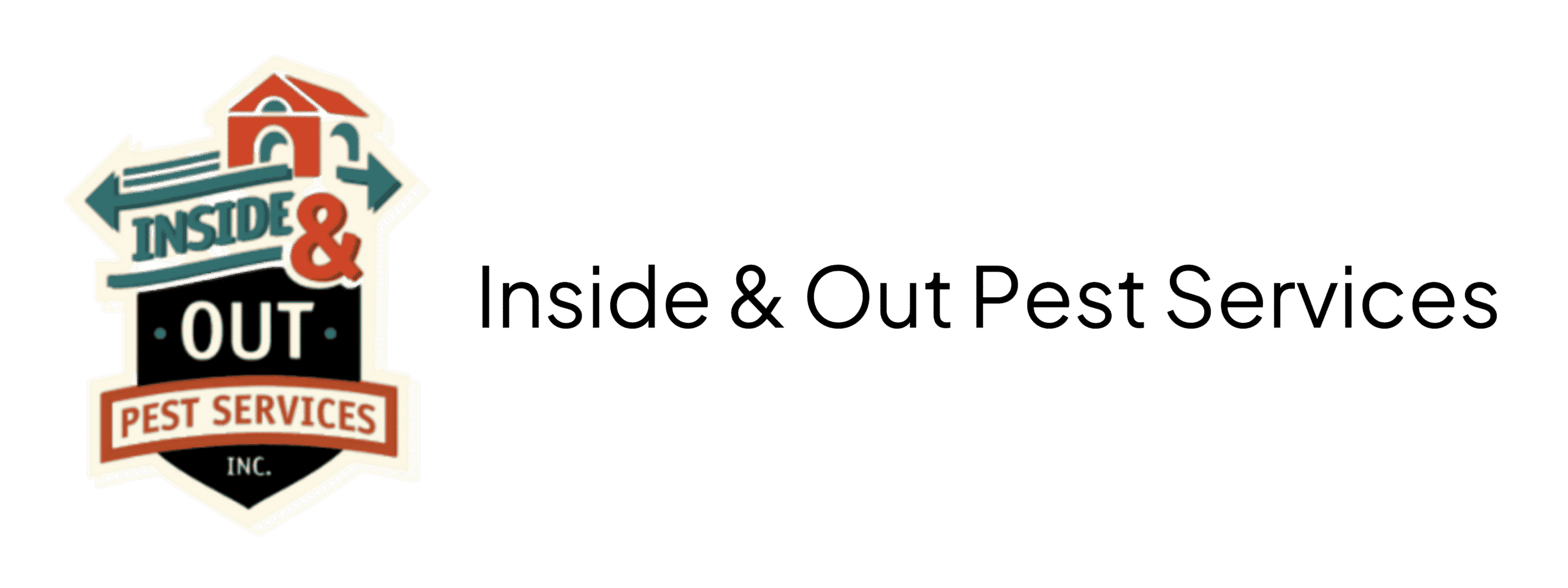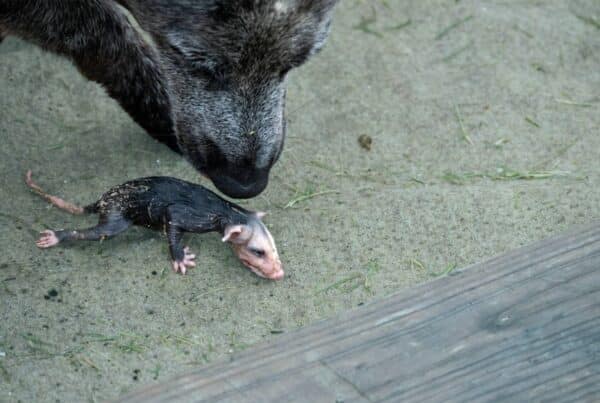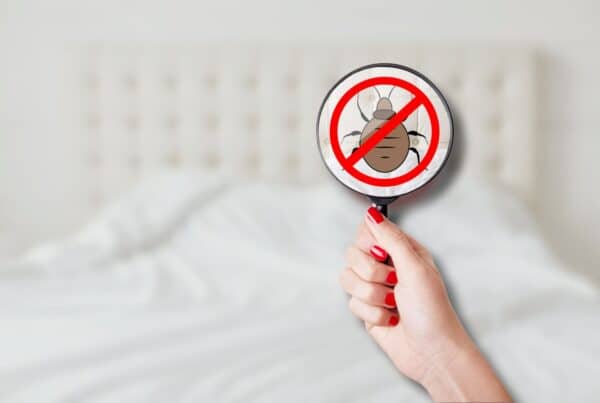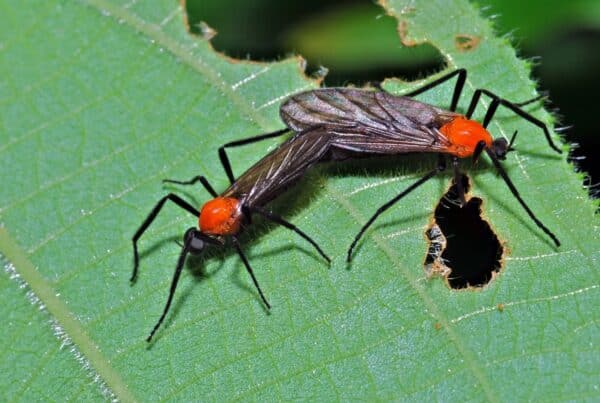This guide from Inside & Out Pest Services covers the most common wasps and other stinging insects in Florida, how to recognize them, and what homeowners can do to prevent problems safely.
If you live in Florida, you know that stinging insects are just part of life outdoors. Whether you are grilling in the backyard or tending your garden, wasps start showing up by mid-spring and stay active through fall.
While most wasps play an important role in controlling other pests, their nests can still create safety concerns near homes and businesses.
Florida’s long warm season allows multiple species and generations of stinging insects to thrive, especially in shaded or protected areas like roof eaves and sheds.
Why Florida’s Climate Attracts Wasps
Florida’s humid, subtropical climate is perfect for wasps and hornets. Unlike northern regions where winter freezes stop reproduction, many stinging insect species here remain active for most of the year.
According to the University of Florida’s Institute of Food and Agricultural Sciences (UF/IFAS), Florida hosts more than 30 species of social wasps, including several that build colonies near residential areas.
The mild climate allows nests to survive longer, and some species continue producing new queens year-round.
Wasps feed on nectar, insects, and even leftover food from outdoor eating areas. The combination of warmth, moisture, and human activity gives them everything they need to build and expand colonies.
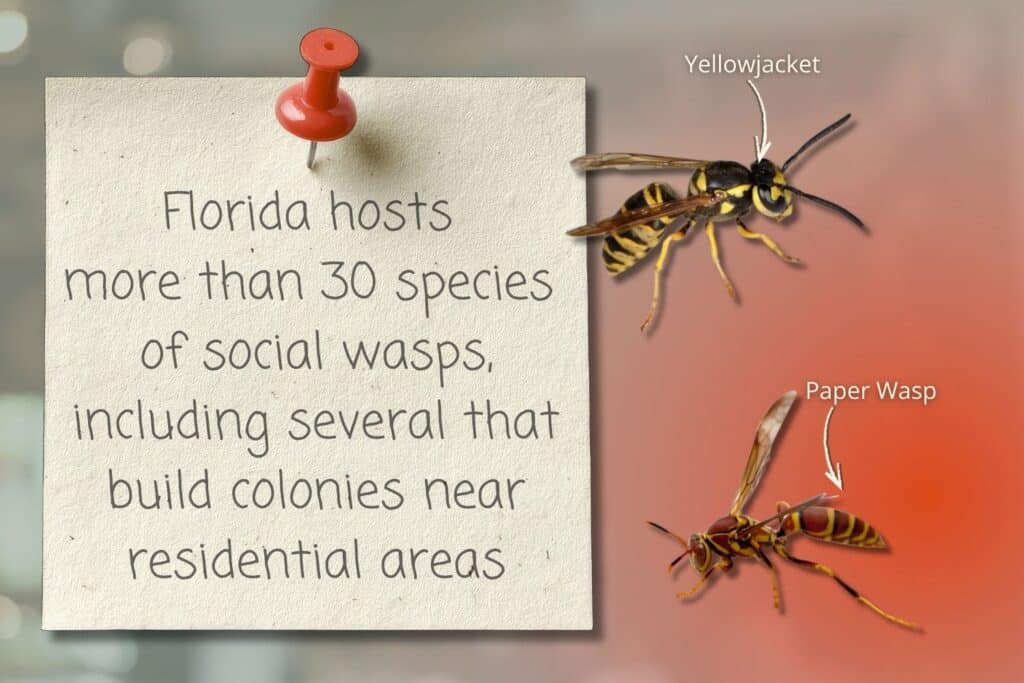
Common Wasps in Florida
Florida is home to several wasp species, each with its own habits and nesting preferences. Recognizing which type you are seeing helps determine how to manage it safely.
Paper Wasps
Paper wasps are among the most common wasps found around homes. They build umbrella-shaped nests under eaves, in mailboxes, or behind shutters.
They are generally not aggressive unless disturbed, but because they defend their colonies vigorously, it is best to avoid removing nests without professional help.
Identification:
- Slender bodies and long legs
- Brownish color with yellow or red markings
- Nests made of thin gray paper material
Paper wasps are most active from March through October in Florida, often returning to the same nesting spots every spring.
Yellowjackets
Yellowjackets are smaller but far more aggressive than paper wasps. They nest underground or inside wall voids, and disturbing a colony can lead to dozens of stings in seconds.
Identification:
- Bright yellow and black stripes
- Smooth, shiny bodies
- Rapid, darting flight pattern
In Florida, yellowjackets start nesting in early spring and grow to their largest numbers by fall. Some colonies contain over 5,000 workers, according to UF/IFAS research.
Hornets
True hornets are actually a type of large wasp. The bald-faced hornet is the most recognizable in Florida. They build large, football-shaped paper nests high in trees or under roof overhangs.
Hornets can sting repeatedly and will defend their nests aggressively, which makes professional removal the safest choice.
Identification:
- Black and white coloration with large heads
- Nests resembling gray paper lanterns
- Loud buzzing when disturbed
Hornets remain active through late summer and fall, with queens overwintering in sheltered spots to start new colonies in spring.
Other Stinging Insects Found in Florida
Florida’s warm climate also supports several other stinging insects homeowners often confuse with wasps.
Mud Daubers
Mud daubers are solitary wasps that rarely sting. They build small tube-like nests made of mud on walls, patios, or outdoor furniture.
They actually help reduce spider populations by paralyzing spiders to feed their young.
Identification:
- Long, thin waist and metallic blue or black color
- Mud tubes under ledges or ceilings
- Slow, deliberate flight patterns
Although mud daubers are beneficial, abandoned nests can attract other insects later in the season, so they should be removed during regular pest control visits.
Sweat Bees
These tiny bees are attracted to perspiration and moisture on human skin. They rarely sting unless pressed against.
Because they look similar to small flies, homeowners may not recognize them until one lands nearby. Keeping outdoor areas dry and trash sealed can reduce their presence.
Carpenter Bees
Carpenter bees look like bumblebees but behave differently. Instead of living in colonies, they drill into untreated wood to lay eggs. Over time, their tunnels can weaken decks or siding.
Inside & Out Pest Services often identifies early signs of carpenter bee activity during general pest inspections and can recommend preventive sealing treatments.
How to Keep Wasps and Other Stinging Insects Away
Even though Inside & Out Pest Services does not advertise direct wasp removal, their general pest control services help reduce the conditions that attract stinging insects in the first place.
Here are effective steps homeowners can take:
1. Maintain Outdoor Areas
Trim shrubs and remove fallen fruit or debris where insects feed. Keep vegetation away from siding and rooflines to reduce nesting zones.
2. Secure Trash and Recycling Bins
Wasps are drawn to sugary residues and food waste. The National Pest Management Association (NPMA) reports that improperly sealed garbage is one of the top attractants for yellowjackets and other wasps in residential areas.
Use bins with tight-fitting lids and rinse containers weekly!
3. Inspect for Early Nesting Activity
Check under eaves, sheds, and deck railings each spring. Removing small paper nests early prevents large colonies later in the season.
4. Reduce Standing Water
Birdbaths, clogged gutters, and pet bowls offer hydration for insects. Empty and clean them regularly to limit wasp activity.
5. Keep Food Covered Outdoors
Open drinks and food attract foraging wasps. Cover items during barbecues and wipe up spills promptly.
6. Schedule Regular Treatments
Routine pest control reduces populations of insects that wasps prey on, including spiders and flies. When their food source is limited, wasps are less likely to settle near your home.
This prevention-based approach aligns with our team’s focus on long-term pest management, not just short-term extermination.

When DIY Removal Becomes Dangerous
Removing wasp nests on your own can be risky. Wasps swarm aggressively when threatened, and stings can trigger serious reactions.
The Centers for Disease Control and Prevention (CDC) estimates that stinging insects cause around 60 deaths per year in the U.S., often due to allergic responses.
DIY sprays may knock down a few wasps but rarely destroy the entire colony. If nests are in wall voids, roof eaves, or attics, professionals have the right equipment to handle them safely.
Even though Inside & Out Pest Services does not perform direct nest removal, their technicians can inspect for attractants and connect homeowners with trusted specialists if a wasp issue requires targeted treatment.
Seasonal Wasp Activity in North Florida
In Jacksonville and nearby regions, wasps begin nesting as early as March and remain active through October or November, depending on weather patterns.
Late spring and summer are the busiest months for nest building, while early fall brings more aggressive behavior as food becomes scarce.
Scheduling pest control visits in spring and again in early fall ensures you catch problems before they grow. Inside & Out’s quarterly plans make that maintenance easy.
Other Related Questions
Are wasps connected to other pest issues?
Yes. Wasps often appear in areas with abundant insects like rodents, spiders and flies. Controlling these food sources with regular pest treatments significantly reduces wasp activity.
Can pest control really help prevent wasps if removal isn’t offered?
Absolutely. Preventive services reduce entry points, food sources, and moisture buildup. The same conditions that attract ants, roaches, and other insects, too. This supports broader pest management goals around the home.
What other Florida pests should I watch for during wasp season?
Ants, mosquitoes, and spiders become more active during the same months. Regular pest maintenance ensures these smaller issues do not create new attractants for stinging insects later in the season.
When to Call a Professional
If you notice multiple nests, wasps entering vents, or frequent activity near doors and windows, it is time to bring in professionals.
Inside & Out offers comprehensive pest services for homes and businesses across Jacksonville and nearby areas.
While they do not directly treat wasp infestations, their regular service visits help stop the pest activity that draws stinging insects to your property in the first place.
Technicians can assess risks, identify attractants, and guide you toward safe, long-term prevention.
Conclusion
Wasps and other stinging insects are a normal part of Florida life, but they should never take over your outdoor space.
Recognizing the species around your home and keeping up with consistent pest control helps you enjoy the season without unwanted visitors.
With the right prevention plan and guidance from Inside & Out Pest Services, Jacksonville homeowners can protect their families and enjoy a pest-free home year-round.
